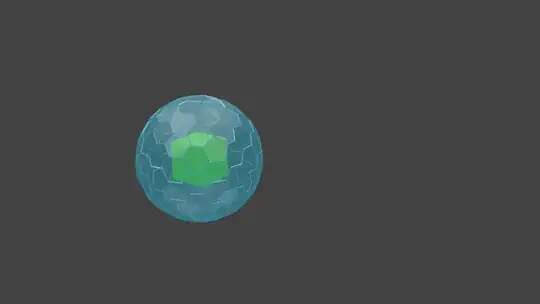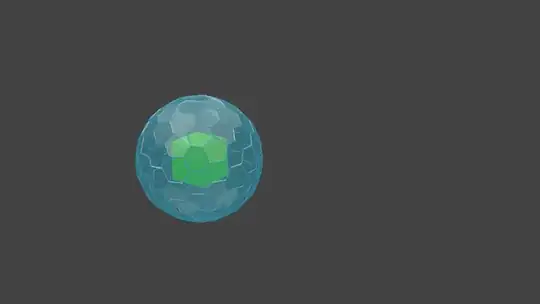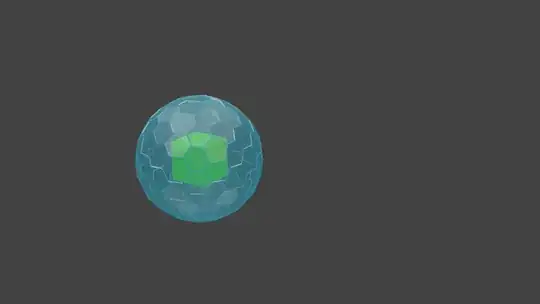The Three Types One Type of Shield
You denote three types of shields1, describing them by their effects:
- 'Instantly' reduces the velocity of incoming objects to zero.
- Accelerates incoming objects outward.
- Destroys incoming objects (and propelling their pieces outward)
However, we can actually describe Types 1 and 3 in a way that they all fit under Type 2.
Type 1 reduces the velocity of incoming objects. This change in speed is an outward acceleration, just a very fast one. This is exactly what Type 2 does.
Type 3 destroys an object and propels the remaining pieces outward. Same as before, we have a change in velocity corresponding to an outward acceleration, like Type 2. The acceleration is so large that it destroys said object.
All three of these types could be said to use the same mechanism, just at different magnitudes.
Trigger Warning: Words
(If you take my word that conservation of momentum is a thing, then you can skip this part.)
I'll paraphrase an excerpt from my answer to Kinetic energy reflection:
Conservation of momentum is a result of Newton's three laws. If we define momentum as the product of an object's mass and its velocity, we can state the laws in this way:
- If no force is applied to an object, its speed (and therefore momentum) does not change.
- The rate at which momentum is added to or removed from an object (rate of change of mass times speed, or mass times acceleration) is equal to the force applied.
- When two objects apply a forces to each other, those forces (and therefore the objects' changes in momentum) are equal and opposite.
The result of all this is that momentum is a conserved quantity:
- Objects cannot create or destroy momentum, only trade it between themselves.
- The total momentum of a system is constant when no external forces are applied.
If it helps, you can think of momentum like charge, where force plays the role of momentum current. The crucial difference is that momentum has a direction that is also conserved.
You all know that Newton has been supplanted by Einstein, so you might argue that there might be some super-physics where the three laws, and therefore conservation of momentum, only hold as an approximation. However, there is a hugely important result in physics called Noether's theorem. It basically states that every spatial symmetry has an associated conserved quantity. In our case this means that if the laws of physics don't change from one place to another, then momentum (the quantity associated with motion) must be conserved. (In general relativity it's actually the 4-momentum that's conserved, which includes an object's 'speed through time;' but that's not important for this discussion.)
Shielded from Physics
We can use the same argument from Kinetic energy reflection to show that all three types of shields would violate conservation of momentum. Basically, it boils down to: the shield doesn't change speed, so its momentum remains the same, however the incoming object does change speed, so its momentum changes. Since those are the only two objects in the system, the total momentum changes, which is not physical.
Forcing it to Work
In order for shields to be possible, we'll have to make a key adjustment: the momentum from the object is transferred to the shield generator. From here it can transfer the momentum to a large mass, like the Earth. (This is exactly what a wall does, transfer momentum into the ground via a momentum current, i.e. a force.)
The upshot of this is that we need a way for the shield generator to apply a force to the object that it wants to stop. Well, as it turns out, there are only four forces for us to choose from:
- Gravitational force: not really an option since we haven't solved gravity yet (although we're working on it!).
- Electromagnetic force: This one is pretty promising, I'll go over it in detail in just a second.
- Strong force: only relevant on the scale of atomic nuclei.2 It decays exponentially with distance.
- Weak force: only relevant in interactions between certain subatomic particles. As the name suggests it is very weak and is also short-range.
It looks like the only good candidate is the electromagnetic force. This encompasses most of the forces we deal with every day though, so we need to break it down a bit:
- Near-field: this includes stuff like interatomic and intermolecular forces.
- Far-field: interactions of electromagnetic waves with matter.
We want far-field interactions, since we want the generator to be far away from the stuff it's repelling!
Frickin' Laser Beams
In order to deliver the large amounts of energy required to the objects we want to stop/destroy, we're going to need some sort of powerful electromagnetic wave. Essentially we've just described a laser.
The only problem is, laser beams are not bubbles. This is disappointing, but inevitable. Basically you can't have some sort of force or energy hanging around somewhere without some stuff to keep it there.
This means that we need to shoot out our lasers at exactly the right time to stop incoming objects. Our 'shield' has basically turned into a directed-energy point-defense system.
Note that although light does carry momentum, we don't actually need to apply external momentum to stop an object. The laser beam will vaporize the surface of the target, and the resulting tiny explosion of plasma will push the object away like a rocket. This is good for stopping objects with high kinetic energy but low momentum, like bullets and missiles, but will be useless against slow-moving objects or ones that can redirect the momentum into the ground (like a tank rolling along); "The shield turns the fast blow, admits the slow knife!". There are some exceptions: some things are going too fast to be stopped,3 while most slow-moving objects will probably be destroyed by your high-energylaser beams.
1 I'm going to use the term "shield" instead of "field" to distinguish the science-fiction meaning of "force-field" from the mathematical and physics notions of 'field'.
2 Although the amount of energy it contributes to neutrons and protons it so high, it gives them almost 99% of their mass (through $E=mc^2$)! Cool, huh?
3 I always like to point out that the glowing trail you see behind the projectile is not propellant: the projectile is smashing the air apart into plasma it's going so fast.


